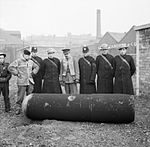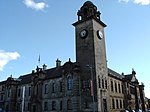Clydebank

Clydebank (Scottish Gaelic: Bruach Chluaidh) is a town in West Dunbartonshire, Scotland. Situated on the north bank of the River Clyde, it borders the village of Old Kilpatrick (with Bowling and Milton beyond) to the west, and the Yoker and Drumchapel areas of the adjacent City of Glasgow immediately to the east. Depending on the definition of the town's boundaries, the suburban areas of Duntocher, Faifley and Hardgate either surround Clydebank to the north, or are its northern outskirts, with the Kilpatrick Hills beyond. Historically part of Dunbartonshire and founded as a police burgh on 18 November 1886, Clydebank is part of the registration County of Dumbarton, the Dunbartonshire Crown Lieutenancy area, and the wider urban area of Greater Glasgow.
Excerpt from the Wikipedia article Clydebank (License: CC BY-SA 3.0, Authors, Images).Clydebank
Whitecrook Street,
Geographical coordinates (GPS) Address Nearby Places Show on map
Geographical coordinates (GPS)
| Latitude | Longitude |
|---|---|
| N 55.8997 ° | E -4.4006 ° |
Address
Whitecrook Street
Whitecrook Street
G81 1QS , Kilbowie
Scotland, United Kingdom
Open on Google Maps







